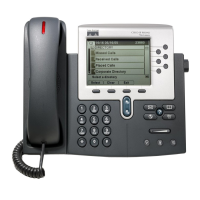2-5
Cisco SIP IP Phone 7960 Administrator Guide
78-10497-02
Chapter 2 Getting Started with Your Cisco SIP IP Phone
Installing the Cisco SIP IP Phone
Configuring SIP Parameters
Note
This section describes how to configure the basic SIP parameters
that are required for the phone to operate in a SIP VoIP environment.
For a complete list of the SIP parameters that you can configure, see
the “Modifying the Phone’s SIP Settings” section on page 3-5.
The SIP parameters are those parameters that a Cisco SIP IP phone needs to
operate in a SIP VoIP environment. You can configure SIP parameters via a TFTP
server or you can manually configure the parameters on a phone-by-phone basis
after connecting the phones.
When the phone initializes, it loads the parameters stored in Flash memory. After
loading the parameters stored in Flash memory, the phone requests the default
configuration file from the TFTP server. If the default configuration file has been
configured and stored in the root directory of the TFTP server, the phone reads the
parameters defined in the file, and stores those parameters that differ in Flash
memory. The phone then requests its phone-specific configuration file. If the
phone-specific configuration file has been configured and placed on the TFTP
server (in the root directory or a subdirectory), the phone reads the parameters
defined in the file and stores those parameters that differ in Flash memory.
Therefore, when configuring SIP parameters, remember the following:
•
Parameters defined in the default configuration file will override the values
stored in Flash memory.
•
Parameters defined in the phone-specific configuration file will override the
values specified in the default configuration file.
•
Parameters entered locally will be used by the phone until the next reboot (if
a phone-specific configuration file exists).
•
If you choose not to configure the phone via a TFTP server, you must manage
the phone locally.

